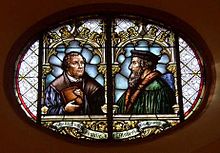
Back Unierede kirker (evangeliske) Danish Unierte Kirchen (evangelisch) German Iglesias protestantes unidas y unificadas Spanish Église unie French Gereja bersatu dan penyatuan ID 合同教会 Japanese 연합교회 Korean Kościoły ewangelicko-unijne Polish Igrejas Unidas Portuguese 合一教會 Chinese

A united church, also called a uniting church, is a denomination formed from the merger or other form of church union of two or more different Protestant Christian denominations, a number of which come from separate and distinct denominational orientations or traditions.[1] Multi-denominationalism, or a multi-denominational church or organization, is a congregation or organization that is affiliated with two or more Christian denominations, whether they be part of the same tradition or from separate and distinct traditions.[2][3]
Historically, unions of Protestant churches were enforced by the state, usually in order to have a stricter control over the religious sphere of its people, but also for other organizational reasons. As modern Christian ecumenism progresses, unions between various Protestant traditions are becoming more and more common,[4] resulting in a growing number of united and uniting churches.
Examples include the United Church of Canada (1925), the Church of South India (1947), the Uniting Church in Australia (1977), the Protestant Church in the Netherlands (2004), and the United Protestant Church of France (2013).[5][6][7][8]
Since the mid-20th century, and the rise of secularism worldwide, mainline Protestantism has shrunk.[9][10][11][12] Among others, Reformed (Calvinist), Anglican, and Lutheran churches have merged, often creating large nationwide denominations.[1] In some countries, Methodist and Congregational denominations have also merged. The phenomenon is much less common among evangelical, nondenominational and charismatic church as new ones arise and many of them remain independent of each other, although in some cases instances of evangelical church congregations joining multiple denominations in a phenomenon known as "multi-denominationalism" does occur; but in most cases Evangelicals cooperate with each other through interdenominationalism while still maintaining denominational distinctions.[2][3]
Perhaps the oldest official united church is found in Germany, where the Protestant Church in Germany is a federation of Lutheran, United (Prussian Union) and Reformed churches, a union dating back to 1817. The first of the series of unions was at a synod in Idstein to form the Protestant Church in Hesse and Nassau in August 1817, commemorated in naming the church of Idstein Unionskirche one hundred years later.[13][14]
Around the world, each united or uniting church comprises a different mix of predecessor Protestant denominations.[1] Trends are visible, however, as most united and uniting churches have one or more predecessors with heritage in the Reformed tradition and many are members of the World Alliance of Reformed Churches.
- ^ a b c "United and Uniting churches — World Council of Churches". www.oikoumene.org. Archived from the original on 2019-08-20. Retrieved 2020-09-04.
- ^ a b "What it means to be multidenominational – The Refuge Place". therefuge.place. Archived from the original on 2023-05-10. Retrieved 2023-05-10.
- ^ a b "Multi-Denomination Congregations in the U.S. and Canada". Paulist Fathers. Archived from the original on 2023-05-10. Retrieved 2023-05-10.
- ^ Haire, James (2017-03-06). Wainwright, Geoffrey; McPartlan, Paul (eds.). "United and Uniting Churches". The Oxford Handbook of Ecumenical Studies. pp. 431–440. doi:10.1093/oxfordhb/9780199600847.013.30. ISBN 978-0-19-960084-7. Archived from the original on 2021-06-26. Retrieved 2020-09-04.
- ^ France, Eglise protestante unie de. "La création de l'Église protestante unie de France". Eglise protestante unie de France (in French). Archived from the original on 2021-05-17. Retrieved 2020-09-04.
- ^ "United Protestant Church of France — World Council of Churches". www.oikoumene.org. Archived from the original on 2020-07-17. Retrieved 2020-09-04.
- ^ "Three-way PKN union drastically changes Dutch denominational landscape » The Windmill news articles » goDutch". www.godutch.com. Archived from the original on 2016-03-04. Retrieved 2020-09-04.
- ^ "Protestant Church in the Netherlands — World Council of Churches". www.oikoumene.org. Archived from the original on 2020-07-19. Retrieved 2020-09-04.
- ^ "Mainline Protestants make up shrinking number of U.S. adults". Pew Research Center. Archived from the original on 2020-09-12. Retrieved 2020-09-04.
- ^ "American Religion Statistics: Trends in U.S. Religious Affiliations". Pew Research Center's Religion & Public Life Project. 2015-05-12. Archived from the original on 2020-09-04. Retrieved 2020-09-04.
- ^ "Amid Evangelical decline, growing split between young Christians and church elders". The Christian Science Monitor. 2017-10-10. ISSN 0882-7729. Archived from the original on 2020-09-11. Retrieved 2020-09-04.
- ^ Burge, Ryan P. "Evangelicals Show No Decline, Despite Trump and Nones". News & Reporting. Archived from the original on 2020-08-30. Retrieved 2020-09-04.
- ^ "Staatlicher Dirigismus und neue Gläubigkeit (Die Kirche im Herzogtum Nassau)" (in German). Nassau-info.de. Archived from the original on 2016-03-03. Retrieved 2011-06-10.
- ^ Block, Mathew (2017-10-05). "Remembering the 200th anniversary of the forced union of Lutheran and Reformed churches in Prussia". International Lutheran Council. Archived from the original on 2020-11-12. Retrieved 2020-09-04.
© MMXXIII Rich X Search. We shall prevail. All rights reserved. Rich X Search